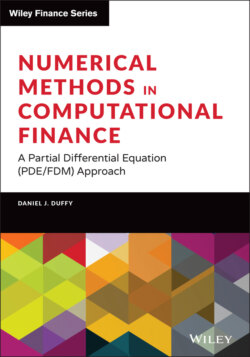Читать книгу Numerical Methods in Computational Finance - Daniel J. Duffy - Страница 69
4.1.1 Notation
ОглавлениеThis chapter attempts to present a self-contained and focused introduction to the essential concepts and methods for vector spaces of finite dimension. The applications are numerous, for example numerical linear algebra, finite Markov chains, multivariate optimisation, machine and statistical learning, graph theory and finite difference methods, to name just a few. To this end, we summarise the most important syntax and notation that we use throughout the book:
F or K : a field
: set of real and complex numbers, respectively
α, β, a, b : scalars
x, y, z : elements of a vector space
V, W : vector spaces
A, B, M : matrices
: norm in a vector space
: transpose of a vector, matrix
: inverse of a matrix
λ : eigenvalue of a matrix
d(x, y) : distance between vectors x and y
(x, y) : inner product of vectors x and y
: n-dimensional real and complex spaces, respectively
: set of real matrices with m rows and n columns
: a vector space V over a field K (see also )
dim V : dimension of a vector space
: linear transformation between two vector spaces and over the same field K
L(V; W) : the set of linear transformations from vector space V to vector space W
: null space (kernel) of a linear transformation whose dimension is n(T)
: the dimension of the range TV of a linear transformation
We use the following important syntax to denote matrices:
(4.1)
These symbols are used in definitions, theorems and algorithms. A good way to learn is to take (simpler) concrete examples before moving to more complex cases and applications.
In time, you should get to the stage whereby you can understand the above notation without having to think twice about it. The same remark holds for all the other notation in this book. It's half the battle!
